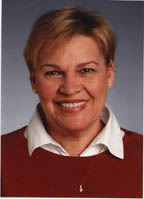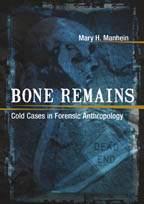Mary H. Manhein

Biography
Mary H. Manhein authored The Bone Lady: Life as a Forensic Anthropologist, Trail of Bones: More Cases from the Files of a Forensic Anthropologist and the mystery novel Floating Souls: The Canal Murders. She is director of the Forensic Anthropology and Computer Enhancement Services (FACES) Laboratory at LSU.
Schedule
Will post information when available

Bone Remains: Cold Cases in Forensic Anthropology
In the past 30 years, forensic anthropologist Mary H. Manhein has helped authorities to identify hundreds of deceased persons in Louisiana and beyond. In Bone Remains, she offers details of 15 riveting cases from her files—many of them involving facial reconstructions where only bones offered clues to an individual’s story.
Manhein takes readers into the field, inside her lab and through DNA databases and government bureaucracies as she and her team tirelessly work to identify and seek justice for those who can no longer speak for themselves. From a 2,000-year-old mummy to Civil War sailors to graves disturbed by Hurricane Isaac, Manhein presents both modern and historic cases. Her conversational accounts provide a fascinating look into the stories behind the headlines as well as sometimes heart-wrenching details of people lost and found.
Manhein shows how each case came to her team, how they used scientific analysis to unravel secrets the bones had to tell and how facial reconstructions and a special database for missing and unidentified people assisted in closing cold cases long believed to be unsolvable. She also discusses several unsolved mysteries, further reflecting the determination and passion central to her career for more than three decades.

Q&A
What are the most important and interesting things readers can learn from your book Bone Remains: Cold Cases in Forensic Anthropology?
How we operate as a repository of information for unidentified and missing persons in Louisiana; how succesful we have been in our efforts to identify the dead; all the many varied projects in which we are involved.....not only solving modern identifications but working on historic mysteries as well.
What motivated you to tell this story?
"This" story is a natural progression from my first two books, Bone Lady and Trail of Bones......which follow my work in the field for the first 20+ years; this book picks up the last 10 or so and is the last in the triology.
What was the most interesting or enjoyable part of the process of writing this book?
Sharing people's stories with others
How do you think this story resonates with Louisiana (culture, readers, history, Louisianans, etc.)?
I think it will resonate with anyone who has felt the loss of a loved one; anyone interested in forensic anthropology and how we do what we do; anyone interested in how real forensic anthropology works as opposed to what one see on television
What excites you about the festival?
I am always pleased to participate in the Louisiana Festival of the Book because it gives you the opportunity to visit with those persons who love the written word.
What should people look forward to by coming to your presentation at the festival?
A lively conversation with someone who lives what she writes about and who loves to share her love of anthropology with others.
Is there anything you’d like to add?
Yes. I would just like to add that the epilogue is one of the most interesting parts of the book to me.....those cases we have not been able to solve and the challenge I toss out there for others.
Volunteer
Book-loving volunteers are essential to the Louisiana Book Festival's success. Whether it's escorting authors, guiding visitors, selling refreshments, working with children in the Young Readers Pavilion or other fun and rewarding assignments, the Louisiana Book Festival wants you to join the volunteer team.


